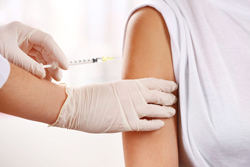The vaccine controversy, which stemmed from a falsified paper from 1998, still seems stronger than ever today despite an overwhelming body of evidence in support of immunizations and their positive effects on public health.
The U.S. Centers for Disease Control and Prevention (CDC) lists immunizations as one of the top ten medical achievements of all time, being directly responsible for the eradication of a laundry list of diseases, including polio and smallpox. A 2014 CDC report showed because of vaccinations given from infancy to childhood, 21 million hospitalizations and 732,000 deaths among children born in the last 20 years will be avoided.
The main source of modern vaccine controversy is a paper published in a scientific journal, the Lancet, in 1998 where Robert Wakefield falsely asserted that there was a link between the measles, mumps, and rubella (MMR) vaccine and autism.
According to Jeffrey Weisburg, Ph.D., a specialist professor of biology, this paper was promptly retracted, as it contained falsified data with a small patient sample size of only 32 individuals. The study was then repeated by other scientists with thousands of other patients, where no correlation between the MMR vaccine and autism was observed.
In response to the accusation that there are monetary conflicts of interest in the new studies, Weisburg stressed that the new studies were undertaken by many financially unrelated parties.
Still, the paper is cited by many anti-vaccine groups as a reason why children should not be immunized, citing an unjustified fear of causing developmental issues.
“The issue is that we’ve gotten much better at detecting autism, and it just so happens that its signs show up at the same time vaccinations are given,” said Weisburg.
Weisburg also believes social media to be the catalyst for the anti-vaccine movement, as fear and ignorance about scientific data can be easily conveyed to mass audiences without fact checks.
“People have a fear of the unknown,” said Martin Hicks, Ph.D., assistant professor of biology and one of the main developers of a vaccine against cocaine. “When people don’t understand the cause of an illness or a disease, they have to ascribe it to something.”
Hicks went on to detail how an overprotective parental instinct may come into play as a reason why people are wary of injections for their children.
“From my understanding, there is no [connection] between vaccination and a person acquiring autism, and those claims were made from a flawed study,” said senior biology student, Brian Reiss.
Another main concern raised by vaccine critics is the presence and possible toxicity of mercury and aluminum, especially in earlier vaccines, as adjuvants. These are added ingredients that help elicit an increased immune response from the body to increase immunity, according to Hicks.
“The mercury levels are less than what you’d get from a tuna sandwich,” said Weisburg. The aluminum and mercury presence are never at levels high enough to do damage, he assures.
Vaccines use the natural ability of the immune system to fight off bacteria and viruses, according to Hicks. Hicks described vaccine production as a process where the pathogen is either “attenuated,” or neutralized, or where molecular indicators like specific proteins are taken and mixed with an adjuvant.
This removes the potential harm associated with the pathogen, as it is unable to evoke illness. Hicks said that side effects like flulike symptoms or slight fever are normal post immunization—it just means the vaccination is working to prep the immune system. The injection of biological indicators essentially teaches the body what disease looks like on a molecular level so that the immune system has the information to defeat pathogen invaders if needed.
This is a mechanism that Hicks believes has wider applications as an alternative to traditional medications and drugs for addiction and cancer if the right molecular markers are used.
Immunizations aren’t just manufactured and administered; they’re closely monitored by the Food and Drug Administration’s (FDA) Center for Biologics Evaluation and Research (CBER).
Regulations on the FDA’s website detail how a proposed vaccine is first presented to the government in an application, where it describes what the vaccine is, the way the vaccine is produced, and information about possible toxicity in animals. If approved, it moves into three stages of clinical trials: Phase 1 is used to test for toxicity and safety, Phase 2 shows the effectiveness and safety of a range of doses of the treatment, and Phase 3 is where the medicine is administered to a wide selection of patients to determine its overall effectiveness.
Afterward, data is analyzed and presented to the FDA, and if given the green light, the vaccine can be administered to the public, only if still monitored during something specific to vaccines: Phase 4. This is where mass data is collected in regard to adverse reactions, if any. All in all, it’s a comprehensive, costly, and time-consuming process to ensure safety and efficacy.
Vaccines increase “herd immunity,” which is detailed by the U.S. Department of Health and Human Services as when “a critical portion of a community is immunized against a contagious disease.”
This means that a disease will have a hard time gaining a foothold in the group preventing outbreaks from occurring.
“Lack of vaccinations leads to a direct decrease in herd immunity, which can lead to the resurgence of a viral disease that has already been eradicated like polio and rubella,” said Koushik Muralidharan, a sophomore biology student.
“People who are concerned should talk to a pediatrician and take time to do their own research,” said Weisburg. “You’re really dealing with disaster when you make the decision not to vaccinate.”
IMAGE TAKEN from the Australian Journal of Pharmacy




